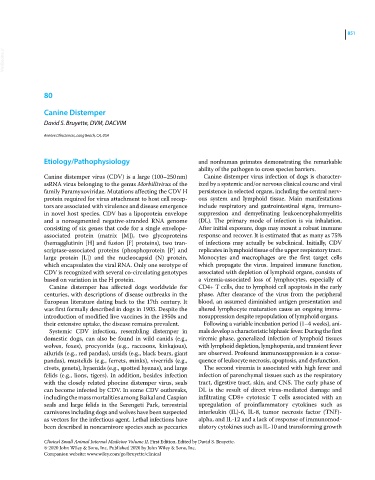Page 913 - Clinical Small Animal Internal Medicine
P. 913
851
VetBooks.ir
80
Canine Distemper
David S. Bruyette, DVM, DACVIM
Anivive Lifesciences, Long Beach, CA, USA
Etiology/Pathophysiology and nonhuman primates demonstrating the remarkable
ability of the pathogen to cross species barriers.
Canine distemper virus (CDV) is a large (100–250 nm) Canine distemper virus infection of dogs is character-
ssRNA virus belonging to the genus Morbillivirus of the ized by a systemic and/or nervous clinical course and viral
family Paramyxoviridae. Mutations affecting the CDV H persistence in selected organs, including the central nerv-
protein required for virus attachment to host cell recep- ous system and lymphoid tissue. Main manifestations
tors are associated with virulence and disease emergence include respiratory and gastrointestinal signs, immuno-
in novel host species. CDV has a lipoprotein envelope suppression and demyelinating leukoencephalomyelitis
and a nonsegmented negative‐stranded RNA genome (DL). The primary mode of infection is via inhalation.
consisting of six genes that code for a single envelope‐ After initial exposure, dogs may mount a robust immune
associated protein (matrix [M]), two glycoproteins response and recover. It is estimated that as many as 75%
(hemagglutinin [H] and fusion [F] proteins), two tran- of infections may actually be subclinical. Initially, CDV
scriptase‐associated proteins (phosphoprotein [P] and replicates in lymphoid tissue of the upper respiratory tract.
large protein [L]) and the nucleocapsid (N) protein, Monocytes and macrophages are the first target cells
which encapsulates the viral RNA. Only one serotype of which propagate the virus. Impaired immune function,
CDV is recognized with several co‐circulating genotypes associated with depletion of lymphoid organs, consists of
based on variation in the H protein. a viremia‐associated loss of lymphocytes, especially of
Canine distemper has affected dogs worldwide for CD4+ T cells, due to lymphoid cell apoptosis in the early
centuries, with descriptions of disease outbreaks in the phase. After clearance of the virus from the peripheral
European literature dating back to the 17th century. It blood, an assumed diminished antigen presentation and
was first formally described in dogs in 1905. Despite the altered lymphocyte maturation cause an ongoing immu-
introduction of modified live vaccines in the 1950s and nosuppression despite repopulation of lymphoid organs.
their extensive uptake, the disease remains prevalent. Following a variable incubation period (1–4 weeks), ani-
Systemic CDV infection, resembling distemper in mals develop a characteristic biphasic fever. During the first
domestic dogs, can also be found in wild canids (e.g., viremic phase, generalized infection of lymphoid tissues
wolves, foxes), procyonids (e.g., raccoons, kinkajous), with lymphoid depletion, lymphopenia, and transient fever
ailurids (e.g., red pandas), ursids (e.g., black bears, giant are observed. Profound immunosuppression is a conse-
pandas), mustelids (e.g., ferrets, minks), viverrids (e.g., quence of leukocyte necrosis, apoptosis, and dysfunction.
civets, genets), hyaenids (e.g., spotted hyenas), and large The second viremia is associated with high fever and
felids (e.g., lions, tigers). In addition, besides infection infection of parenchymal tissues such as the respiratory
with the closely related phocine distemper virus, seals tract, digestive tract, skin, and CNS. The early phase of
can become infected by CDV. In some CDV outbreaks, DL is the result of direct virus‐mediated damage and
including the mass mortalities among Baikal and Caspian infiltrating CD8+ cytotoxic T cells associated with an
seals and large felids in the Serengeti Park, terrestrial upregulation of proinflammatory cytokines such as
carnivores including dogs and wolves have been suspected interleukin (IL)‐6, IL‐8, tumor necrosis factor (TNF)‐
as vectors for the infectious agent. Lethal infections have alpha, and IL‐12 and a lack of response of immunomod-
been described in noncarnivore species such as peccaries ulatory cytokines such as IL‐10 and transforming growth
Clinical Small Animal Internal Medicine Volume II, First Edition. Edited by David S. Bruyette.
© 2020 John Wiley & Sons, Inc. Published 2020 by John Wiley & Sons, Inc.
Companion website: www.wiley.com/go/bruyette/clinical

